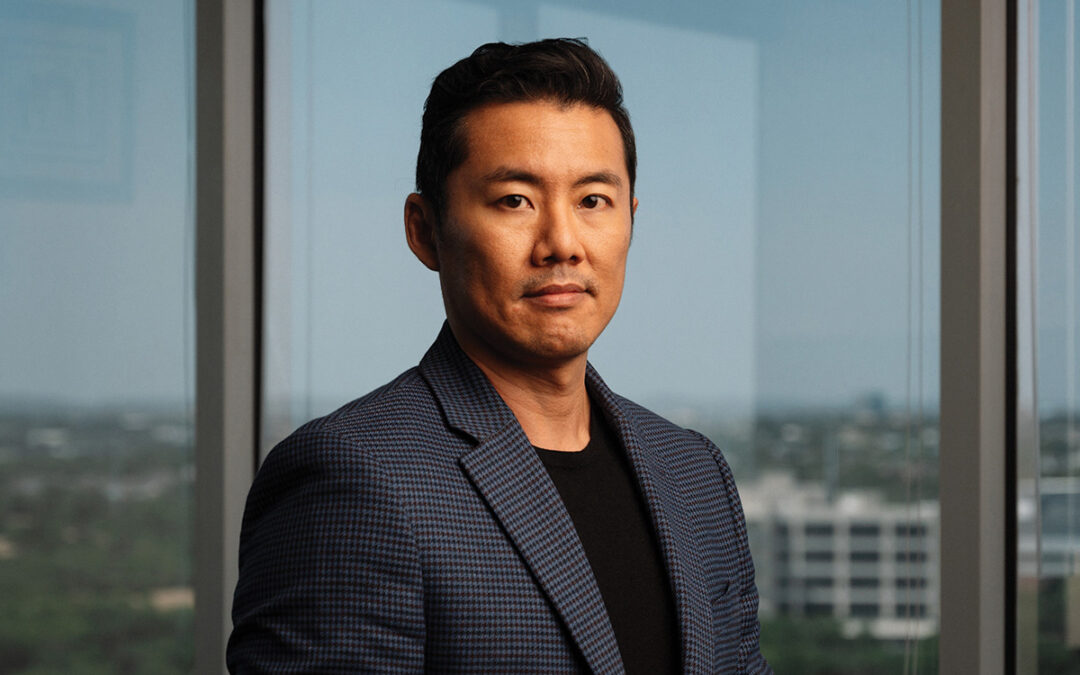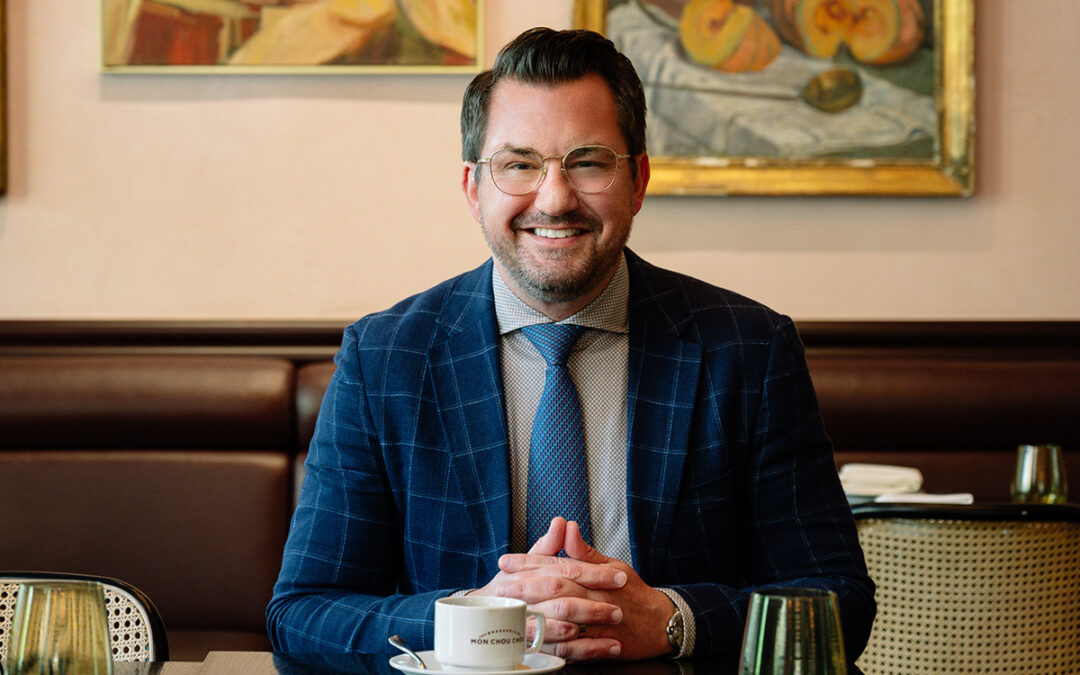Gerald “Jerry” Wilmink,
Ph.D., M.B.A., CEO Founder of WiseWear
BY JASMINA WELLINGHOFF
PHOTOGRAPHY BY
ELIZABETH WARBURTON
Dr. Gerald “Jerry” Wilmink earned his B.S., M.S. and Ph.D. in biomedical engineering from Vanderbilt University and, more recently, an M.B.A. from UT Austin, all of which prepared him well for what he is doing today as the founder and CEO of WiseWear, a promising tech startup that makes “wise” wearables. Though a number of companies have rushed into this field, WiseWear’s products, aimed at women, are actually attractive enough to wear as jewelry.
At present, the company offers three styles of bracelets that hide a sensing device that monitors fitness-related parameters the number of steps walked, distance traveled, calories burned and total active time. In addition, should the wearer find herself in an emergency situation, she can simply tap her bracelet to send a distress signal to a predetermined list of contacts, along with information about her location.
What makes these products unique is the material used and their stylish look. No cheap plastic here. The three styles, collectively dubbed the Socialite Collection, are all made of brass, plated in gold and palladium. The bracelets connect to your phone, giving the wearer more options.
Prior to launching WiseWear in 2013, Wilmink worked first as a research associate with the National Academy of Sciences, in which capacity he founded and led the first terahertz (Thz)-sensing lab for the Defense Department. The lab co-developed the first THz spectrometer to assess skin burn injuries in battlefield situations. (Terahertz radiation is part of the electromagnetic spectrum, between microwaves and infrared light waves, but the technology to detect or use its power was practically nonexistent at the time.)
We met with Dr. Wilmink at his company’s headquarters on the North Side, where at least 10 biomedical and electrical engineers are busy developing health-related tech devices.
What brought you to San Antonio?
When I got my Ph.D., I didn’t know what I wanted to do when I grew up. So I was exploring research positions and received the National Academy of Sciences postdoctoral research fellowship to start a new lab for the Department of Defense — the Terahertz Biosensing Laboratory. That was located at Brooks City Base here.
What motivated you to start WiseWear?
The inspiration was my grandfather Dominic Cameratta. I was raised by him and my mother. He suffered from a condition called Lewy Body Dementia, which is a cross between Alzheimer’s and Parkinson’s. His symptoms included memory issues and changes in gait and balance issues. In 2010, he got up in the middle of the night, lost his balance and fell. He passed away the day after Christmas that year.
Before passing, however, he asked me, “When are you going to start that medical device business that you’ve been talking about since graduate school?”
I have always wanted to create devices that help people, and that’s why I pursued biomedical engineering. However, in the research environment I never felt like I was making a real impact in helping people. His death was the beginning of this whole idea. Our first product was a hearing aid that had three elements – it functioned as a hearing aid but also had sensors that detected dehydration and the ability to tell seniors that they were in danger of falling down. It was the first preventive way to prevent older people’s falls. That product requires FDA approval, and it’s still in production.
Along the way we patented an antenna system that allows us to transmit Bluetooth within the confines of a metal medical device. Previous wearables were made of plastic because it’s easy to transmit Bluetooth signals to a smart phone through plastic. We patented a system that allows us to transmit these signals through metal. This breakthrough was the foundation of our business. Women don’t want to wear plastic; they want to wear real jewelry.
That’s a huge leap forward for wearables.
Our selection of metal is genius on a number of levels. First, our system allows us to transmit Bluetooth signals 10 times further than normal Bluetooth, which is a big deal. And here is a cool thing: Our products are mix-and-match. We call it “the beauty and the brain.” (He proceeds to demonstrate how the bracelet can be separated into the top “beauty” part and the lower “brain” part and how the same brain part may be recombined with a different top for a different look.)
Who designed the styles of the Socialite Collection?
We believe that form, function and fashion truly intersect in our products. We are partnering with some leading designers from New York City. Our first designer was Lee Chen, who served as a chief operating officer at Ippolita and also worked for Swatch and Tom Hardy. She is now on our board. She and her team flew in from New York, and we designed the collection together. And we have plans to do other collections with other designers as well.
Are the bracelets available for sale, and if so, where?
Through our website (wisewear.com), and soon from some major retailers, but we can’t discuss their names at this time.
On your website I saw a product called Evolve. What is it?
There are five products in production here. The bracelets are the first to hit the market. Evolve is a health and fitness monitoring device for professional sports players and fitness enthusiasts. It’s not a jewelry-type product.
You are often invited to speak at various conferences such as TEDMED and SXSW. What do you talk about?
I am invited to speak on a variety of topics — technology, entrepreneurship, innovation and about how we developed our products. I’ve probably given a few hundred talks by now and published 60-plus papers on sensor technology and engineering. I also have 10 pending patents worldwide. I was a pretty big nerd before I chose this (current) route. I ran a research lab, so I published a lot of papers about our research. I also served as a program manager for the Department of Defense SBIR (Small Business Innovation Research program) and in that capacity helped businesses develop innovative sensing products.
What is your advice for budding entrepreneurs?
My main advice is, if you are starting a business, don’t do it to get rich. If you want that, become a hedge fund manager! My advice is, find the sweet spot … If you have a passion for something and you have the right skills, start the business because you can have a positive impact on the world. (He draws three circles on the board to represent passion, skills and impact, explaining that the sweet spot is where those three partially overlap.) If you can get to the intersection of these three things, you’ll never work a day in your life. That’s my best advice for someone who wants to start a business.
Dr. Wilmink’s comments have been edited for publication.










0 Comments